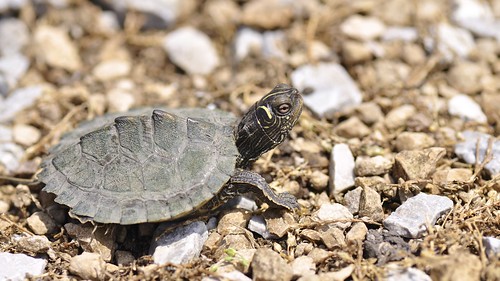false map turtle
(Graptemys pseudogeographica)
Conservation • Description • Habitat • Biology • Distribution • Taxonomy
Description |
||
False map turtle is one of three map turtles that occur in Minnesota. It is native to the United States from Ohio to Alabama, west to Minnesota and eastern Texas. It is found in large rivers, in their backwaters and oxbows, and in lakes, ponds, and wetlands fed by those rivers. In Minnesota it is found in and near the Mississippi, Minnesota, and St. Croix Rivers as far north as Chisago County. There is a single record from Crow Wing County and another from Aitkin County, but those may be non-indigenous individuals. This and other map turtles are sold as aquarium pets. Many have been sold in Europe, and some of these were subsequently released into the wild. False map turtle now occurs throughout eastern Europe, where it competes with native species and is considered invasive. Size is usually given as the length of the upper shell (carapace). The male carapace is 3½″ to 5⅞″ (8.9 to 15.0 cm) in length. Females are much larger, with an 8″ to 10⅝″ (20.3 to 27 cm) carapace length. The carapace is olive to brown, and is marked with a network of fine, yellow lines. The lines resemble contour lines on a map. This is the feature that gives the genus its common name. The lines are distinct on juveniles but become less distinct as the turtle matures. There is often a black, smudge-like spot on each scale (scute). The rear margin is flared and saw-toothed. On young turtles the carapace is distinctly keeled, and there is a longitudinal row of saw-toothed knobs down the middle. On mature adults it is only slightly keeled. On males the knobs remain pronounced, but on mature females they almost completely disappear. The lower shell (plastron) is cream-colored or yellow. It is not hinged. On juveniles the seams between the scutes are dark, but these will usually fade completely by maturity. The head, neck, and limbs are olive to dark olive with thin yellow or yellowish-white (pale) lines on the legs, tail, chin, and neck. The eyes are housed in bony orbits. There are three pale spots on each side of the head: one behind each eye (postorbital), one below the eye (suborbital), and one on the side of the lower jaw. The postorbital spot is bold, rectangular, and fused with a thin line running down the neck, usually forming an L or “hockey stick” shape. |
||
Size |
||
Male: 3½″ to 5⅞″ (8.9 to 15.0 cm) Female: 8″ to 10⅝″ (20.3 to 27 cm) |
||
Similar Species |
||
Habitat |
||
Large rivers, backwaters, oxbows, lakes, ponds, and wetlands |
||
Biology |
||
Behavior |
||
|
||
Lifespan |
||
30 to 50 years in the wild |
||
Life Cycle |
||
|
||
Food |
||
Both sexes feed on insects, including caddisflies, mayfly larvae, and damselfly larvae; on small fish; and on vegetation, including pondweed, and duckweed. Females, being larger, also feed on mollusks. Males, being smaller, also feed on beetle and fly larvae and on algae. |
||
Distribution |
||||
|
Sources |
|||
| 3/11/2023 | ||||
Occurrence |
||||
|
||||
Taxonomy |
|||
| Class | Reptilia (Reptiles) | ||
| Order | Testudines (turtles and tortoises) | ||
| Suborder | Cryptodira (hidden-necked turtles) | ||
| Superfamily | Testudinoidea | ||
Family |
Emydidae (pond and box turtles) | ||
Subfamily |
Deirochelyinae | ||
Genus |
Graptemys (map turtles) | ||
Subordinate Taxa |
|||
Mississippi map turtle (Graptemys pseudogeographica kohnii) false map turtle (Graptemys pseudogeographica pseudogeographica) |
|||
Two subspecies, G. p. pseudogeographica, and G. p. kohnii, have been described. Two analyses (Ernst and Barbour, 1989 and Conant and Collins, 1991) raised G. p. kohnii to species status. A later analysis (Vogt, 1993) contended that G. kohnii should be considered a subspecies of G. pseudogeographica. A more recent mitochondrial analysis (Lamb et al., 1994) determined that G. kohnii clearly falls within the G. pseudogeographica clade, but went on to say that there was no evidence of infraspecific variation in any species. The two subspecies are currently recognized by most sources, including The Reptile Database, ITIS, NCBI, GRIN, IUCN Red List, NatureServe, and iNaturalist. |
|||
Synonyms |
|||
Clemmys pseudogeographica Emys lesueurii Emys pseudogeographica Emys pseudo-grographica Malacoclemmys lesueurii Malacoclemmys pseudogeographicus |
|||
Common Names |
|||
false map turtle Mississippi map turtle |
|||
Glossary
Carapace
The hard, upper (dorsal), shell-like covering (exoskeleton) of the body or at least the thorax of many arthropods and of turtles and tortoises. On crustaceans, it covers the cephalothorax. On spiders, the top of the cephalothorax made from a series of fused sclerites.
Plastron
The hard, lower (ventral), shell-like covering (exoskeleton) of the body of turtles and tortoises.
Scute
A hard, external scale that forms part of the exoskeleton; as on the belly of a snake, the upper and lower shells of hard-shelled turtles, and the foot of a bird.
Visitor Photos |
|||||
Share your photo of this reptile. |
|||||
| This button not working for you? Simply email us at info@MinnesotaSeasons.com. Attach one or more photos and, if you like, a caption. |
|||||
Jeff LeClere |
|||||
 |
 |
||||
MinnesotaSeasons.com Photos |
|||||
|
|||||

Visitor Videos |
|||
Share your video of this reptile. |
|||
| This button not working for you? Simply email us at info@MinnesotaSeasons.com. Attach a video, a YouTube link, or a cloud storage link. |
|||
Other Videos |
|||
| False Map Turtle (Graptemys pseudogeographica) Wisconsin Citizen-based Monitoring Network |
|||
About
Mar 13, 2013 False Map Turtle profile: https://dnr.wi.gov/topic/EndangeredResources/Animals.asp?mode=detail&SpecCode=ARAAD05080 |
|||

Created: 3/11/2023
Last Updated:




